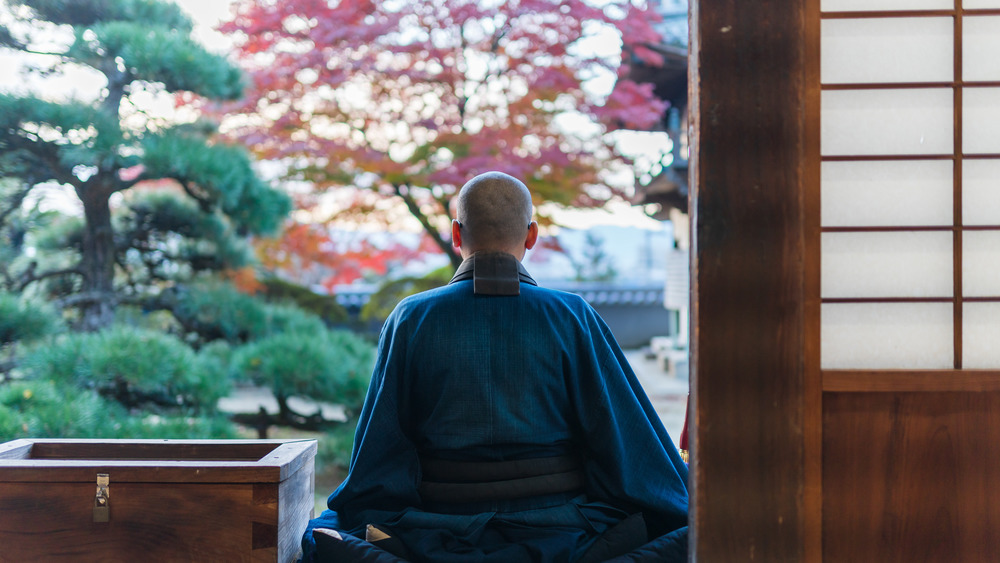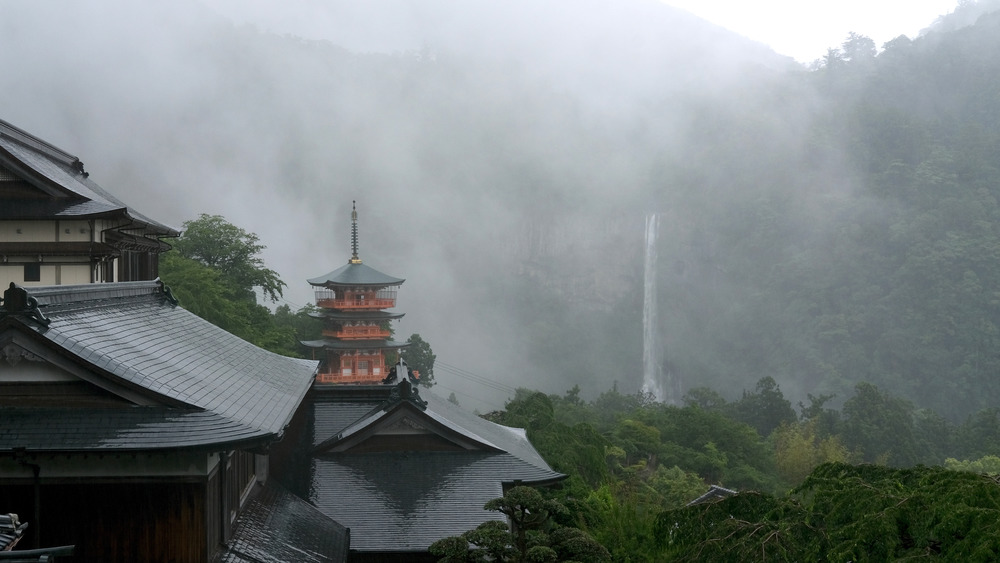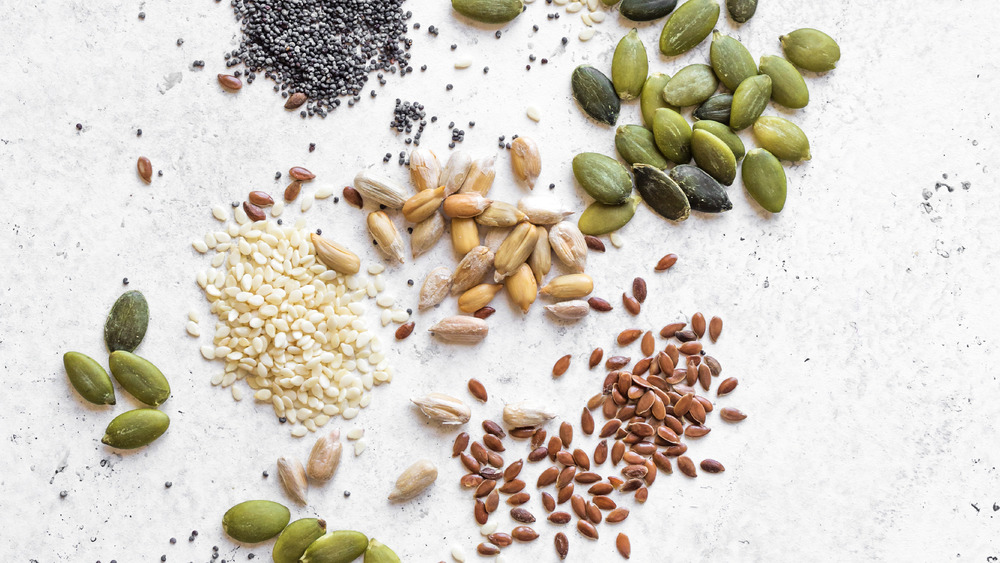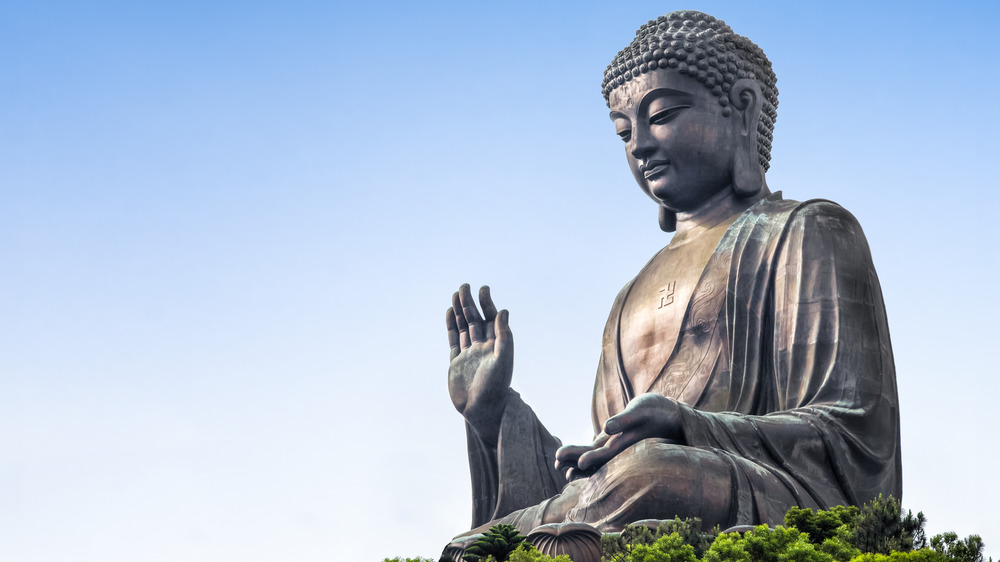The Spiritual Practice Of Self-Mummification
When you think of mummies you might envision those ACE bandage-wearing guys pulled from sarcophagi in Egypt — you know: all pharaonic, shrunken and distributing curses — or maybe Universal Picture's miserably failed Dark Universe launch circa 2017's Tom Cruise-led The Mummy. (Actually, we're betting you didn't even remember that movie until right now, although you might remember Brendan Fraser's identically named 1999 movie.) But what you don't probably think of is desiccated Buddhist monks hardened into a permanent, multi-hundred-year-old seated lotus position.
This is exactly the case, though, with members of Shingon, an ascetic, nondoctrinal sect of Buddhism that arose during Japan's Heian period (794-1185 CE), built from the tethers between Japan's native Shinto animism and Buddhism as it was imported from mainland China. Shingon monks followed Shugendo, described by the Japanese Journal of Religious Studies as a loose set of traditions and lore, and much like their far-flung civilizational forbears in ancient Egypt, practiced mummification. But rather than use root extracts, natural plant gum, and conifer tree resin applied to an organless, salted, and embalmed body (per the BBC), or letting peat bogs do the trick like Tollund Man in Denmark (per Museum Silkeborg), these monks became mummified while they were alive. And how? Well naturally, they did it to themselves.
Good news? No organ extraction was necessary while living. Also possibly good: the practice ceased in the late 19th century, per Vintage News, as the government decreed it cruel self-treatment akin to suicide.
Practiced by the Shingon monks of Japan
To be fair, Shugendo monks weren't the only ones mummifying themselves. Famed Thai mummy-monk Luang Pho Daeng, seen in this Medium article sporting what might be Ray Bans, sits eternally waiting for fans and photo-ops at Wat Khunaram on the island of Ko Samui. Another self-mummified Chinese monk named Qisan Zhang now rests inside a 1,000-year-old statue stolen from its village of Yongchun in 1995 and put on display in Budapest before winding up in the Netherlands, as Quartz explains.
The practice, though, seemingly originated in Japan with the rise of Shingon Buddhism. Some sources point to a mystic and ascetic named En no Gyoja, who in 699 was apparently banished from the imperial court for having "supernatural powers," as Culture Trip tells us. Most commonly, though, a monk named Kukai (774 – 835 CE) is credited as the sect's progenitor, driven by what the Japan Times describes as a contest between Shingon and its rival, Tendai Buddhism, over control of Mount Yudono, a sacred mediational site. And so, to prove his point (we assume), Kukai was the first to become sokushinbutsu: a mummy-monk meant to embody principles of self-denial. In Kukai's case, he also intended to "emerge in approximately 5.67 million years to usher a predetermined number of souls into nirvana," per Atlas Obscura.
Kukai, known posthumously by the honorary "Kobo Daishi," set an example that would be followed, and procedurally honed, for centuries. i09 describes the procedure as "gruesome" and "excruciating."
The grueling, agonizing process of self-mummification
As Atlas Obscura says, it took until 1081 CE for another monk, Shojin, to try and follow in Kukai's footsteps and enter a state of perceived, perpetual mediation, but he failed and merely rotted away like anyone else. It took centuries of trial and error (and yeah, deaths) for monks to figure out the correct process.
Shugendo's first step to self-mummification involved stripping away body fat by ingesting a diet of only nuts, seeds, and roots from Mount Yudono. Would-be sokushinbutsu did this for 1,000 days, minimum, and sometimes in two or three cycles. The idea was to remove from the body anything that bacteria and parasites would be attracted to, thereby slowing decomposition. After this, monks cut out solid food altogether, and only drank poisonous tea made from the Urushi tree (similar to poison ivy), which, as Chinese Buddhist Encyclopedia tells us, caused intense vomiting and removed as much fluid from the body as possible. Then, they cut out water completely and waited to die.
When monks were ready to enter this state, dubbed "nyujo," they were buried alive. Lowered into a pine box three meters underground, packed with charcoal, monks sat in a lotus position and breathed through a tube connected to the world above. In total darkness they meditated, and each day rung a bell. When the bell stopped ringing, those outside assumed that the monk had died. In another 1,000 days the body was disinterred and checked for decay.
Buddhas enshrined in physical, earthly forms
The newest sokushinbutsu, Tetsuryukai, who self-mummified in 1881 after the practice was made illegal, joins a small cadre of only about 24 individuals of the Shingon sect of Buddhism who successfully passed into what was believed to be a form of enlightenment. In fact, as the Japan Times says, these mummy-monks were considered actual, eternally fleshly Buddhas. After being exhumed, each of their bodies was placed in a shrine, dressed in robes, and worshipped. Those who failed? No word on their everlasting fate, but they were revered for their bravery and determination, nonetheless.
At present, domestic and international tourists alike can travel to see any of the remaining sokushinbutsu. Some have gotten destroyed over the years, leaving 16, and 13 of them are in Yamagata Prefecture in the Tohoku region of Japan, as i09 says. There's a full list of each monk visible for viewing and the locations on Japan Reference. One of the most famous mummies, Daijuku Bosatsu Shinnyokai-Shonin, who mummified himself at the age of 96 in 1783, currently resides in Ryusui-ji Dainichibou Temple in Tsuruoka City in Yamagata Prefecture.
Over time, as Japan entered the Meiji era (1868 – 1912 CE) and modernized, and especially after the practice of self-mummification was outlawed, people began to view the monks more as madmen than wise men. No matter how they might be viewed today, the remains of their dogmatism are certainly a thing to behold.



